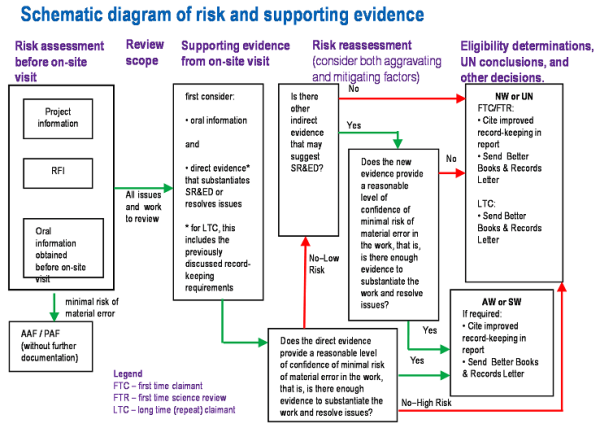Updated CRM For RTAs Part Eight: Risk Assessment vs. Supporting Evidence
Reference Article (>5 Years Old)

Scientific Research and Experimental Development (SR&ED) applications are as varied as the work claimed within them, meaning that different claims require different types of supporting evidence for corroboration. So how does a Research and Technology Advisor (RTA) determine just how much supporting evidence is sufficient?
In our previous post, we outlined the different forms of supporting evidence, and how a Research and Technology Advisor (RTA) treats them. This article will expand on the topic, addressing:
- Schematic diagram of risk;
- Breakdown of schematic;
- Risk assessment versus evidence requirement.
Read the other articles in this series: Part One: Clarified Definitions; Part Two: First Time Claimant (FTC) Review vs. FTCAS; Part Three: ATIP and Information Requests; Part Four: Information Gathering by RTAs; Part Five: SR&ED Claim Review Process and Project Issues; Part Six: Written Review Plans; and Part Seven: Supporting Evidence & Oral Information.
Diagram Of Risk And Supporting Evidence
Note: We encourage you to read the CRA’s full explanation of the schematic diagram offered in section 5.6.6.3 of the CRM.
The updated Claim Review Manual (CRM) states that the CRA’s recommended approach is to use the Risk Management Policy to mitigate the risk of processing an ineligible or insufficiently substantiated claim. This policy is simplified into the schematic, and is explained further below:
The schematic illustrates the stages of a review of the work claimed, in the context of the RTA requesting documentation and supporting evidence. It starts from the time the RTA does the initial risk assessment, and if a review is undertaken, to the determination of eligibility or the resolution of other review issues. It illustrates that risk assessment is on-going throughout the review and that risk can change as new information becomes available. It also illustrates the decisions to be taken after any new information is gathered and has been risk assessed. The decisions and actions are grouped under 5 column headings.1
The diagram above is a simplification of a significantly more well-rounded policy guideline. However, the updated CRM also offers a detailed breakdown of the schematic to help claimants better understand the complexity of a claim review.
Risk Assessment vs. Supporting Evidence
Visualizing the risk assessment process is of little use if claimants don’t understand the possible outcomes associated with the conclusions and decisions of these assessments. As such, the updated CRM educates claimants about the courses of action pursued by RTAs at each level of assessed risk (emphasis added):
If the initial risk assessment was low, the RTA then considers the indirect evidence. Indirect evidence of SR&ED is evidence that suggests SR&ED but not actually proving it to be SR&ED. Some examples of indirect evidence of SR&ED (discussed in chapter 5.6.6.1) are invoices, emails, rough sketches, and scrapped materials. If the indirect evidence is sufficient to reduce the risk of material error, the RTA proceeds to step five. This situation should not happen with long-term claimants, since a long-term claimant would have been advised in prior reviews of the supporting evidence requirements. Although the requirements on record keeping are the same for all claimants, the long-term claimant is also expected to comply with previously discussed records keeping requirements. Therefore, for the long-term claimant it is expected that there be direct evidence or the type of supporting evidence previously required to be kept for subsequent reviews. If the indirect evidence is insufficient, the risk has now become high, and the RTA proceeds to step five.
If the initial risk assessment was high, direct evidence is needed, and in the absence of direct evidence, the risk remains high, and the RTA then proceeds to step five. In exceptional circumstances, the RTA can still make a decision or an eligibility determination if there is an abundance of indirect evidence. The RTA can and should rely on their professional judgement and experience to arrive at a decision or determination in such cases.
For all issues, if there is no or insufficient indirect evidence to corroborate the claimant’s oral information, then the RTA is led to a no work (NW) determination, unsubstantiated (UN) conclusion, or unfavourable decision, depending on the situation.2
Schematic Diagram of Risk: In Closing
Section 5.6.6.3 of the updated CRM provides a useful overview of the schematic’s function:
The schematic ties together a number of things such as:
- reducing risk of material error to a minimal level;
- the need to obtain oral information;
- the need to corroborate oral information;
- the use of direct evidence;
- the use of indirect evidence; and
- the expectations for a FTC vs. a long term claimant (LTC).3
The schematic diagram allows claimants to gain deeper insight into the risk assessment policy of RTAs and has addressed questions about differing evidence requirements for different cases. Now, it is logical that higher risk claims necessitate a higher standard of supporting evidence. Explaining the mitigating factors (i.e. prior history of compliance with the CRA) and aggravating factors (i.e. inconsistent testimony/evidence) that can alter a risk assessment increases the likelihood of a painless SR&ED review.
With these insights, the CRA has done its due diligence. This information is readily available in the updated CRM, so any further ignorance or lack of understanding regarding the SR&ED claim review process is solely the fault of the claimant, and cannot be explained by a lack of transparency within the CRA’s administration of the SR&ED program.
This article is based on CRA policy documents available at the date of publication. Please consult the CRA website for the most recent versions of these documents.
